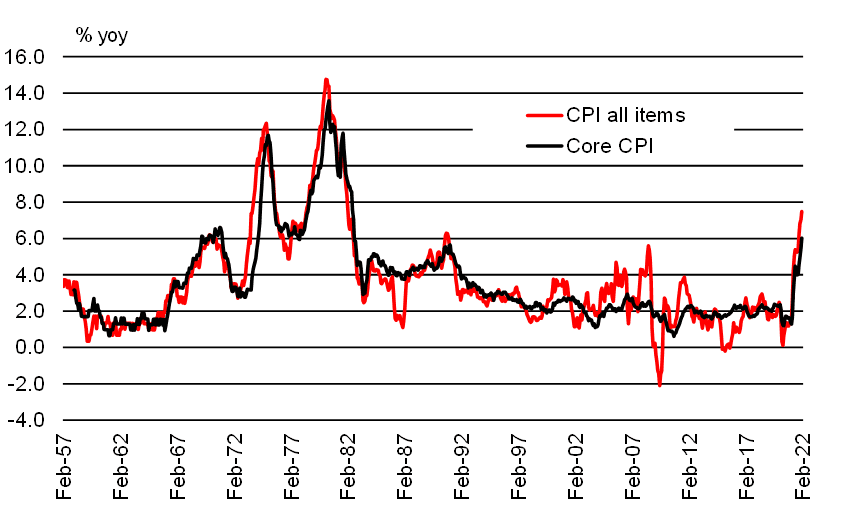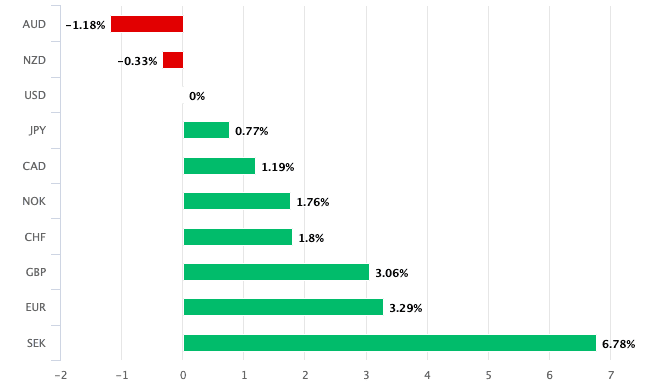Dollar Bid, Searing Inflation Underscores why the Fed Will Race to Hike
- Written by: Gary Howes
-

Image © Adobe Images
The Dollar looks set to extend its multi-week trend of appreciation against the Pound and Euro amidst dour market sentiment linked to the Ukraine war and news that U.S. inflationary pressure has broadened.
Markets now expect up to 160 basis points of hikes out of the Federal Reserve in 2022 after the U.S. reported core inflation rose to 6.4% year-on-year in February, ahead of estimates for 5.9%.
CPI inflation met analyst expectations after it rose 7.9% year-on-year in February, up on January's 7.5%.
"The Fed needs to act swiftly to contain broadening price pressures," says economist Katherine Judge at CIBC Capital Markets.
Above: A 40-year high for inflation. Chart: UniCredit.
The Fed is expected in 2022 to deliver more rate hikes than the Bank of England, European Central Bank and all other G10 central banks, apart from the Reserve Bank of New Zealand.
This is proving a source of support to the Dollar.
The Pound to Dollar exchange rate is lower by 0.40% at the time of writing at 1.3131 while the Euro to Dollar exchange rate is down two-thirds of a percent at 1.1008.
"Price rises were again broad-based but were led by gasoline, food and shelter," says Daniel Vernazza, Chief International Economist at UniCredit Bank in London.
Russia's invasion of Ukraine has meanwhile led to a sharp rise in commodities prices, particularly energy, which suggests further inflationary prices will build.
"The rise in crude oil prices means gasoline prices will surge in March, likely pushing the headline 12-month rate to above 8%. It should mark the peak, as negative base effects start to push down on the 12-month rate, but uncertainty is very high," says Vernazza.
- GBP/USD reference rates at publication:
Spot: 1.3119 - High street bank rates (indicative band): 1.2760-1.2852
- Payment specialist rates (indicative band): 1.3000-1.3053
- Find out about specialist rates and service, here
- Set up an exchange rate alert, here
The inflation data prodded an already bearish stock market, one that typically favours the safe-haven and highly liquid U.S. Dollar.
"It looks like yesterday’s bounce might have been a bit of a one-hit wonder, a product of short covering and thinner liquidity. Nothing over the past 24 hours really suggests a major change in tone, and for now the downside case continues to prevail, bolstered by continued fears about inflation and the shift towards hawkishness in central bank thinking," says Chris Beauchamp, chief market analyst at IG.
Stock markets rose through 2020 and 2021 spurred by the ample liquidity provided to the global financial system by the Federal Reserve's ultra-low interest rates and quantitative easing.
The supply of 'easy money' has however no come to an end and markets are adjusting lower.
The implied scarcity of Dollars that such tightening presents is in itself likely to be a compelling driver of demand for dollars.
Above: USD has outperformed in 2022, with only the AUD and NZD adding more value.
The anti-cyclical Dollar would however likely turn direction and head lower when global growth recovers and U.S. economic outperformance starts to be look less exceptional.
This looks unlikely to occur anytime soon, particularly with little sign of a peaceful conclusion to the Ukraine conflict.
Analysts had picked up on various comments from Ukrainian and Russian officials at various points this week as proof there was scope for a negotiated settlement.
The strong move higher in equities in the midweek session, which also saw the Euro and Pound rise against the Dollar, was in part attributed to these hints that a negotiated settlement was possible.
But Russian and Ukrainian negotiators concluded talks in Turkey on Thursday with no progress being made and this has served as a cold reminder to investors these are incredibly difficult markets to navigate.
Moscow and Ukraine are entrenched in their positions, the war goes on and all the while inflation burns hotter, leaving central banks little choice but turn off the liquidity taps.
These are conditions favourable to further Pound-Dollar weakness.












